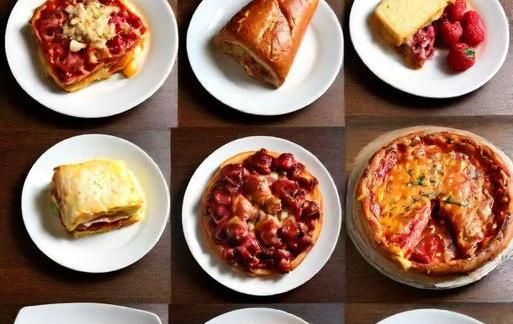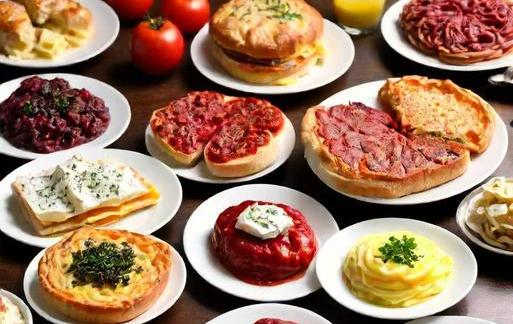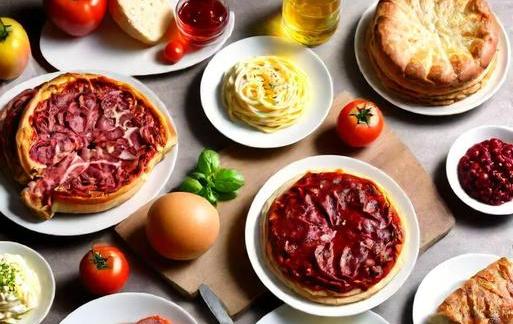- You are here:
- Home »
- Food
- » [REVEALED] European Foods That Start With Q
[REVEALED] European Foods That Start With Q
Note: This page contains affiliate links.
As an Amazon Associate, I earn from qualifying purchases when you click on the link, but you are not charged extra.
European cuisine is a rich tapestry of diverse flavors, ingredients, and culinary traditions that have evolved over centuries. Exploring the culinary landscape of Europe is a delightful journey through a plethora of dishes that reflect the cultural, historical, and geographical uniqueness of each region. In this article, we delve into a specific aspect of European gastronomy – foods that start with the letter Q. While not as common as some other letters, Q presents an intriguing challenge that leads us to discover hidden gems and culinary wonders. Join us on this gastronomic expedition as we explore the intriguing world of European foods that start with Q.
Contents
List Of European Foods That Start With Q

1. Quark
Origin: Germany
Quark, a fresh and creamy dairy product, originates from Germany. It resembles a cross between yogurt and cream cheese, with a mild flavor and a slightly grainy texture. Germans often use Quark in both sweet and savory dishes, making it a versatile ingredient in their cuisine. It serves as a base for desserts, spreads, and even in salads.
2. Quiche
Origin: France
Quiche, a savory tart filled with a mixture of eggs, cream, cheese, and various ingredients such as meats, vegetables, or seafood, hails from France. This classic dish has gained international popularity and comes in various regional variations. The French take pride in their mastery of creating the perfect quiche, showcasing the artistry of combining simple ingredients into a harmonious culinary creation.
3. Queso Manchego
Origin: Spain
Queso Manchego, a famous Spanish cheese, is made from the milk of Manchega sheep. It boasts a distinctively tangy and nutty flavor, with a firm and compact texture. This cheese is often enjoyed on its own or paired with fruits, nuts, and wine. Queso Manchego holds a designation of origin, signifying its authenticity and adherence to traditional production methods.
4. Quaglie Alla Griglia
Origin: Italy
Quaglie alla Griglia, translating to Grilled Quail in English, is an Italian dish that showcases the culinary finesse of Italian chefs. Quail, known for its tender and flavorful meat, is marinated with herbs and spices, then grilled to perfection. This dish reflects the Italian approach to combining simplicity with the highest quality ingredients to create a memorable dining experience.
5. Quarkbällchen
Origin: Germany
Quarkbällchen, also known as Quark balls, are a delightful German treat. These are deep-fried pastries made with Quark, flour, and eggs, resulting in a light and fluffy texture. Typically dusted with powdered sugar, Quarkbällchen are a popular sweet snack during festivals and celebrations in Germany. Their irresistible taste and texture make them a favorite among locals and visitors alike.
6. Quaglia Con Polenta
Origin: Italy
Quaglia con Polenta, meaning Quail with Polenta, is another Italian dish that combines the rich flavors of quail with the comforting texture of polenta. The quail is often roasted or braised, and it’s served on a bed of creamy polenta, creating a harmonious balance of taste and texture. This dish reflects the rustic charm and hearty nature of Italian cuisine.
7. Quetschentaart
Origin: Luxembourg
Quetschentaart is a traditional Luxembourgish plum tart that showcases the delicious versatility of plums. The tart is made with a buttery pastry crust and filled with sliced plums, sugar, and sometimes a hint of cinnamon. It is often enjoyed as a dessert or a sweet treat during Luxembourg’s festive occasions.
8. Quarktaschen
Origin: Germany
Quarktaschen, similar to Quarkbällchen, are German pastries that feature Quark as a primary ingredient. These are pastry pockets filled with a sweetened Quark mixture, creating a delightful blend of textures. Often baked until golden brown, Quarktaschen are enjoyed as a dessert or a sweet snack, showcasing the Germans’ expertise in creating delectable treats.
9. Quaglia Ripiena
Origin: Italy
Quaglia Ripiena, or Stuffed Quail, is an Italian dish that elevates the quail to a gourmet level. The quail is carefully deboned and filled with a flavorful stuffing, often containing a mix of breadcrumbs, herbs, and sometimes ground meat. This dish exemplifies the intricate artistry of Italian cuisine, where each element is thoughtfully prepared to create a symphony of flavors.
10. Quinoa Salad
Origin: Across Europe
While quinoa itself is not native to Europe, its incorporation into European cuisine has been notable. Quinoa salads have become a popular and healthy choice across the continent. These salads often feature a mix of fresh vegetables, herbs, feta cheese, and a light vinaigrette dressing. The versatility of quinoa allows it to seamlessly integrate into various European culinary traditions, providing a nutritious and delicious option for health-conscious food enthusiasts.
The exploration of European foods that start with the letter Q unveils a fascinating array of dishes that span across Germany, France, Spain, Italy, and Luxembourg. From the creamy goodness of Quark to the savory allure of Quiche and the gourmet sophistication of Quaglia Ripiena, each dish reflects the culinary expertise and cultural richness of its country of origin. As we traverse the diverse landscapes of European cuisine, we discover that the letter Q, though not as commonly used, presents us with a treasure trove of gastronomic delights. Whether it's the sweet indulgence of Quarkbällchen in Germany, the robust flavors of Quaglia con Polenta in Italy, or the comforting simplicity of Quetschentaart in Luxembourg, each dish adds a unique dimension to the culinary mosaic of Europe. So, the next time you find yourself on a culinary adventure in Europe, don't overlook the subtle charm of foods that start with Q. Whether you're savoring the delicate flavors of Quail in an Italian dish or relishing the creamy goodness of Quark in a German creation, you're sure to be captivated by the culinary magic that Europe has to offer. Bon appétit!
Significance

European cuisine is a rich tapestry of flavors, with each country contributing unique dishes that have stood the test of time. Exploring the culinary delights of Europe often leads us to familiar names like pasta from Italy, croissants from France, or paella from Spain. However, in our gastronomic journey, let’s delve into a specific aspect – European foods that start with the letter “Q”. While Q may not be as prolific as some other letters in the culinary world, Europe surprises us with a delightful array of dishes and ingredients that bear names beginning with this distinctive letter.
Why focus on European foods that start with Q? The significance lies in the exploration of less commonly known dishes, ingredients, and culinary traditions. It allows us to broaden our understanding of European cuisine, uncover hidden gems, and appreciate the diversity that exists beyond the mainstream. This journey into Q-named foods takes us beyond the ordinary, revealing the unique and sometimes overlooked aspects of European gastronomy.
Category-Related

1. Quiche Lorraine (France)
One of the most iconic French dishes, Quiche Lorraine, hails from the northeastern region of Lorraine. A savory tart, it traditionally features a filling of eggs, cream, and bacon or lardons. The combination of a buttery crust and a flavorful custard-like filling makes Quiche Lorraine a beloved classic in French cuisine. Variations may include additions like cheese, onions, or vegetables, offering a versatile canvas for culinary creativity.
2. Quenelle (France)
Originating from Lyon, the quenelle is a dumpling-like dish with a unique shape and texture. Typically made from a mixture of fish or meat, breadcrumbs, and eggs, the quenelle is poached and often served with a rich sauce, such as Nantua sauce made with crayfish. This delicacy showcases the French artistry of combining simple ingredients into a dish that is both refined and comforting.
3. Queso (Spain)
While the term "queso" simply means cheese in Spanish, it is an integral part of Spanish cuisine. Spain boasts a wide variety of cheeses, each region producing its own distinctive flavors. From the sharp Manchego to the creamy Cabrales, Spanish queso plays a pivotal role in tapas, desserts, and various traditional dishes. The sheer diversity of Spanish cheeses adds depth and character to the country’s culinary landscape.
4. Quark (Germany)
A staple in German cuisine, quark is a fresh dairy product with a texture reminiscent of Greek yogurt. This versatile ingredient finds its way into both sweet and savory dishes, contributing to the richness of desserts like Käsekuchen (German cheesecake) or enhancing the creaminess of sauces. Its mild flavor and creamy consistency make quark a favorite among German chefs and home cooks alike.
Common Themes
As we explore European foods starting with Q, common themes emerge, showcasing the interconnectedness of these culinary delights across borders.
1. Quintessential Ingredients
Many Q-named foods feature quintessential ingredients that define the culinary identity of their respective regions. For instance, quark in Germany highlights the importance of fresh dairy in German cooking, while queso in Spain showcases the diversity of cheeses that contribute to the complexity of Spanish dishes.
2. Versatility In Preparation
Whether it’s quiche in France or quenelle in Lyon, the versatility in preparation is a recurring theme. These dishes provide a canvas for culinary expression, allowing chefs and home cooks to experiment with various fillings, toppings, and accompaniments. This adaptability speaks to the dynamic nature of European cuisine.
3. Culinary Heritage And Tradition
Each Q-named dish carries a piece of culinary heritage and tradition. Quiche Lorraine, with its roots in the Lorraine region of France, reflects the local flavors and preferences of its origin. Similarly, quark in Germany is a product of longstanding dairy traditions, passed down through generations.
Interesting Facts
1. Quince (Not Just A Fruit)
While the quince itself is a fruit, it also plays a unique role in European cuisine beyond being a simple snack. In some regions, quince is used to make preserves, sauces, or even added to savory dishes. The transformation of this fruit into various culinary delights showcases the ingenuity of European cooks in utilizing local ingredients.
2. Quorn (A Modern Addition)
In the realm of contemporary European cuisine, the mention of Quorn is noteworthy. Originally developed in the United Kingdom, Quorn is a meat substitute made from a fungus. Widely used in vegetarian and vegan dishes, it has gained popularity for its meat-like texture and ability to absorb flavors. Its inclusion in European diets reflects the evolving landscape of culinary preferences.
3. Quaint Regional Variations
Exploring European foods starting with Q reveals quaint regional variations. For example, the quenelle in Lyon may have subtle differences compared to a version found in another part of France. These nuances highlight the diversity within a single country’s culinary landscape, emphasizing the importance of regional identity in European cooking.
Conclusion
In our culinary exploration of European foods that start with Q, we’ve uncovered a diverse range of dishes and ingredients that contribute to the rich tapestry of European cuisine. From the classic Quiche Lorraine in France to the versatile quark in Germany, each Q-named culinary delight tells a story of tradition, innovation, and regional identity. The significance of these foods goes beyond their names; they are gateways to understanding the history, culture, and flavors that define the European culinary experience. As we savor the unique tastes of these dishes, we embark on a journey that transcends borders and invites us to appreciate the depth and diversity of European gastronomy.


